We’re now halfway through week 21 of Vladimir Putin’s 72-hour Special Military Operation to eliminate Ukraine. For the previous edition, read Putin’s War, Week 19. Political Uncertainty, Lots of New Weapons, and a Replay of the Western Front. Let’s take a look and see how things are going.
Politico-Strategic Level
Most of the action has taken place at the politico-strategic levels. I don’t feel terribly comfortable commenting on some of the happenings because I don’t want to look like David French trying to write about conservatism. Things are happening; they have some meaning. However, the meaning may not be terribly clear.
Government Shake-up. In early July, Ukrainian President Volodymyr Zelensky fired five ambassadors. No reason was given, but they seem to have been overly aggressive with the heads of state of the countries where they were assigned. I would guess that the situation has changed since early in the war to one requiring a smoother approach rather than publicly shaming politicians for not supporting Ukraine’s defense.
Last Sunday, the former head of Ukraine’s security service, the SBU, for operations in Crimea was arrested by the SBU under a warrant charging him with treason. He’d been fired after the rapid collapse of Ukrainian defenses in Kherson Oblast. That made him just the latest of 60 SBU members who defected to Russia early in the war or who have been arrested for supplying intelligence information to the Russians. This shouldn’t be a shock as the upper crust of the SBU was trained in Moscow at the same school that trained the KGB and now trains the FSB. This seems to have been the straw that broke the camel’s back. Zelensky sacked SBU chief and childhood friend Ivan Bakanov, one of Bakanov’s senior deputies, along with Prosecutor-General Iryna Venediktova.
The day after sacking the SBU chief, Zelensky signed a decree stripping ten very prominent Ukrainians of their citizenship, something that is legal there if you hold more than one passport. Some of them were simps for Russia, but one of them was the wealthiest man in Ukraine, Ihor Kolomoysky. Kolomoysky was instrumental in backing the Maidan Revolution that booted Russia’s puppet out of Kiev. His media empire provided the launching pad for Zelensky’s entertainment career, and he was thought to have a significant degree of influence over Zelensky and his cabinet ministers. Kolomoysky’s closest friends were also on the list of those deprived of citizenship. There are stories circulating that Kolomoysky was on the verge of defecting to the Russians. Had that happened, the political damage to Zelensky would have been immense. Right now, that is in the “cool story, bro” category as no evidence has been presented.
I have no pretensions to be an authority on the inner workings of any government, much less that of Ukraine. Given Kolomoysky’s history of close ties to Russia, my guess is that his view of how to manage the war and Zelensky’s had diverged to the point where they were incompatible. I imagine Zelensky also wanted to get rid of the charge of being Kolomoysky’s sockpuppet. So rather than fight a political war as well as a real war, Zelensky chose to go full-metal Godfather on the opposition.
By the way, Zelensky has been given a lot of grief by some on the right for banning the pro-Russia parties and media operating in Ukraine. That country is in the midst of a war. We didn’t allow pro-Nazi parties and media to operate in the US during WW II. If you want to take a whack at Zelensky for that, knock yourself out but in my opinion, it is an exercise in self-beclowning.
Boris Johnson Resigns. Boris Johnson’s resignation as British prime minister is a huge blow to Zelensky as Johnson was his most reliable and generous ally in Europe. The UK is hosting Ukrainian soldiers undergoing basic combat training or training on weapons systems. In addition, the British Special Boat Service provided training and equipment to their Ukrainian counterparts to liberate Snake Island. The two leading contenders for the prime minister’s job are both supportive of Ukraine, but one, Rishi Sunak, is alleged to have family financial ties to Putin’s regime, and his rhetoric doesn’t give one comfort that he would do much more than cheer from the sidelines.
Conflict Expansion. The problem with any war is that it is difficult to contain. This is no different.
Belarus is mustering its forces on its southeastern frontier with Ukraine and making threats to Poland. The Belarus army is sort of a joke, but Russia is using airbases and ammo depots in Belarus to carry out strikes in Ukraine. It is a matter of time until Ukraine gets tired of this. Belarus Grand Poohbah Aleksandr Lukashenko is in a precarious position. Don’t be shocked to wake up one morning and find a pro-Ukraine, pro-Poland revolution has sent him into exile…or is parading his head around Minsk on a pike.
Moldova’s hang-fire war with “Transnistria” is back in the news. I’ve written on this forgotten conflict before; see Putin Decides to Widen the War With Ukraine to Achieve His Objectives. Long story short: in 1991, Russia backed an AstroTurfed “separatist” movement in Moldova. In 1992, the Russians imposed a ceasefire that included stationing a 1,400-man brigade and ammunition storage areas in Transnistria. Last week Moldova announced that the Russians in the “peacekeeping” force would not be allowed to travel through Moldova to rotate home. The odds of them going through Ukraine are about zero. There are no major airports in Transnistria. Russia is all stompy-foot, but it is difficult to see what they can do if Moldova holds firm. Ukraine has promised Moldova that it will take care of the Russians if conflict breaks out. The Moldovan army is not a First World army, but it is much better trained, organized, and equipped than it was in 1991 and exponentially more capable than the militia Transnistria can pull together.
Russian Grain Blockade. Ukraine is one of the world’s largest wheat producers and the largest source for the Middle East and North Africa. However, Russian naval supremacy and both sides mining the approaches to Odesa have effectively shut down Ukrainian exports of wheat and seed oils. The blockade would result in famine in parts of the world. Work is underway to reroute this commerce through Poland, but it will take a few years to build the necessary transportation and storage infrastructure to support this move. Friday, Russia and Ukraine, using Turkey as an intermediary, signed a deal to allow the shipment of Ukrainian wheat from Odesa. Saturday, Russia hit infrastructure in Odesa’s harbor with a missile attack.
The moment the Russian missile struck the port in Odesa today.
(Video was given to my @ABC colleague by an eyewitness) pic.twitter.com/DlD5nG8P2d— Patrick Reevell (@Reevellp) July 23, 2022
one day after signing agreement to allow ukraine grain export from odesa, russia launches missile strikes against odesa… pic.twitter.com/AO4sH6EAOr
— ian bremmer (@ianbremmer) July 23, 2022
The Russians claimed they were targeting “a docked Ukrainian warship and a warehouse with Harpoon anti-ship missiles.” What the Russians did, and I think the purpose of the attack, was scuttle the grain export agreement by ensuring that commercial vessels can’t get insurance to carry cargo out of Odesa. So effectively, the grain embargo remains in place, and Russia can claim, and its simps can amplify the claim that it agreed to allow grain out of Ukraine, and they don’t know why Ukraine isn’t shipping it.
EU Fecklessness. Russia has discovered the pressure point in the coalition arming and training Ukraine: their gutlessness. In the last report, I covered Lithuania’s decision to impose EU sanctions on Russian traffic to the stolen enclave of Kaliningrad (Lithuania Enforces EU Sanctions on Kaliningrad and Putin’s Toadies Lose Their Minds). The EU decided that sanctions didn’t cover shipments to Kaliningrad. A turbine for the Russian Nord Stream pipeline was shipped from Canada to Germany after an exemption from sanctions was granted.
Operational Level
As always, I like to start this by reviewing the first 90-days of the war. Otherwise, gains and losses take on unwarranted significance.
This is the frontline today.
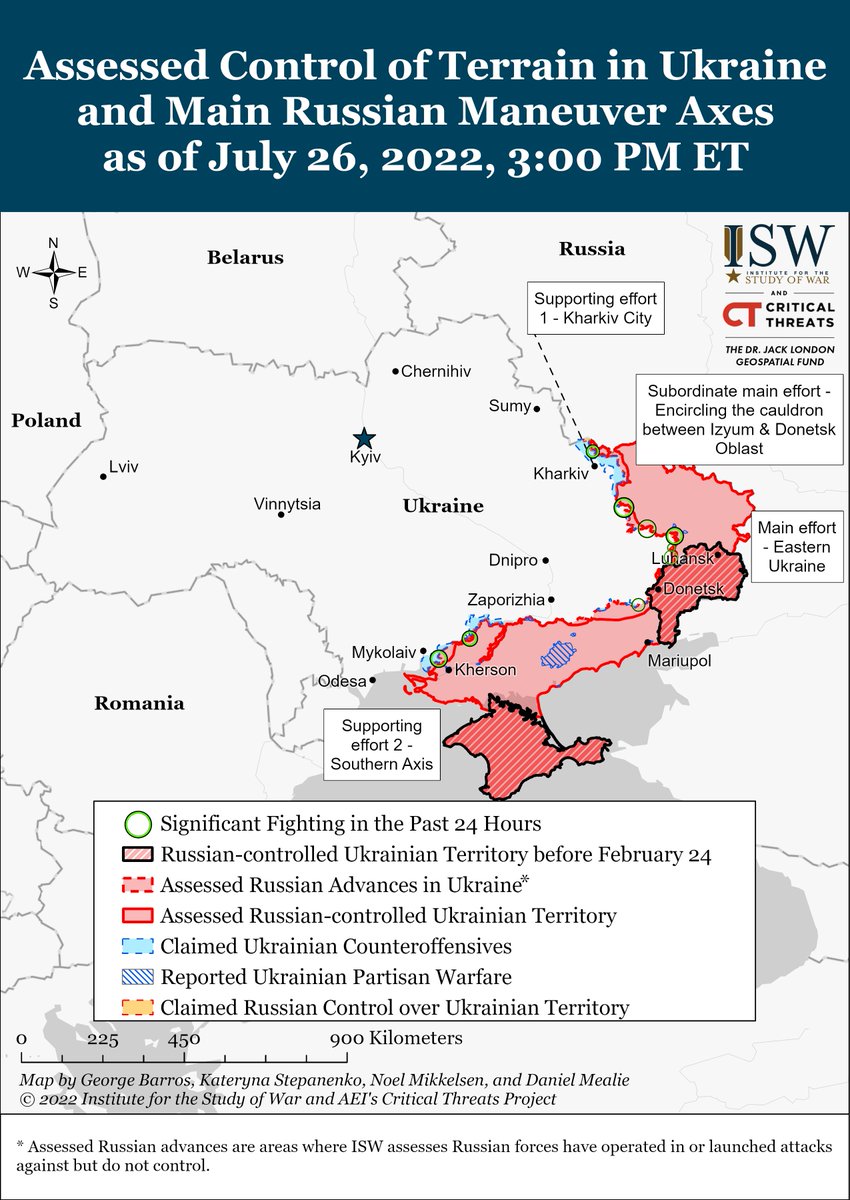
Credit: Institute for the Study of War
New Weapons in Action
The weapon that is getting everyone’s attention is the M-142 High Mobility Artillery Rocket System (HIMARS).
HIMARS overmatches any rocket artillery system used by the Russians. It is more accurate (HIMARS accuracy is ±5 meters; the Russian systems are ±1,000 meters), fires faster (reload in 5 minutes versus nearly an hour), and has almost double the range. This weapon system places all division and lower headquarters, ammunition dumps, surface-to-air missile batteries, and repair yards in the war zone in jeopardy. The HIMARS tracked cousin is the M-270 MLRS; Ukraine has about a half-dozen of those.
I’m not a believer in wonder weapons, but HIMARS shows the promise, should it be handled aggressively and with intelligence, to bring Russian advances to a complete halt and prepare the battlespace for counteroffensives.
British L119 105mm howitzers are finally in action. The British Army transferred 36 of the weapons to Ukraine in June. Crews have completed their training in the UK and are in Donbas.
The L119 is not as sexy as the big guns, but the presence of the 105mm allows fire support to frontline troops and frees up 155mm systems and HIMARS to hunt Russian artillery, supply dumps, headquarters, air defense units, and troop concentrations.
The first three of a promised 15 German Gepard anti-aircraft have arrived in Ukraine.
Putin’s War has showcased the importance of drones in the Intelligence, Surveillance, Reconnaissance and Target Acquisition mission. Currently, it is an unequal fight on both sides, requiring a relatively expensive missile to shoot down a relatively inexpensive, if not outright dirt cheap, drone. The Gepard fires anti-aircraft munitions; it also has an armor piercing sabot round for vehicular targets. Pairing the Gepard with higher-value units equipped with artillery systems will dramatically reduce their losses to counterbattery fire.
Britain’s Stormer High Velocity Missile System has also arrived in the theater. It is a carrier for the StarStreak missile that has been in use for a few months in its man-portable role. Like the Gepard, Stormer will protect high-value assets from Russian drones and engage low-flying fixed-wing aircraft and helicopters.
Poland has already supplied Ukraine with over 200 obsolescent T-72 tanks. I use the word obsolescent advisedly as they match the best armor Russia has in Ukraine. Now the Poles are supplying an “undetermined” number of domestically produced PT-91 tanks. They are essentially T-72 tanks but with every system upgraded to relatively modern levels. When they arrive, they will be the most advanced tanks in the war but not in the same class as the US Abrams or British Challenger.
Training of Ukrainian troops is underway in Britain and other countries. Thousands have completed the basic training course on the way to a goal of training 10,000. Once a substantial cadre has been trained, they can expand the training program back home.
There haven’t been a lot of new Russian weapons introduced, but the S-300 anti-aircraft system is now being pressed into service as a surface-to-surface missile.
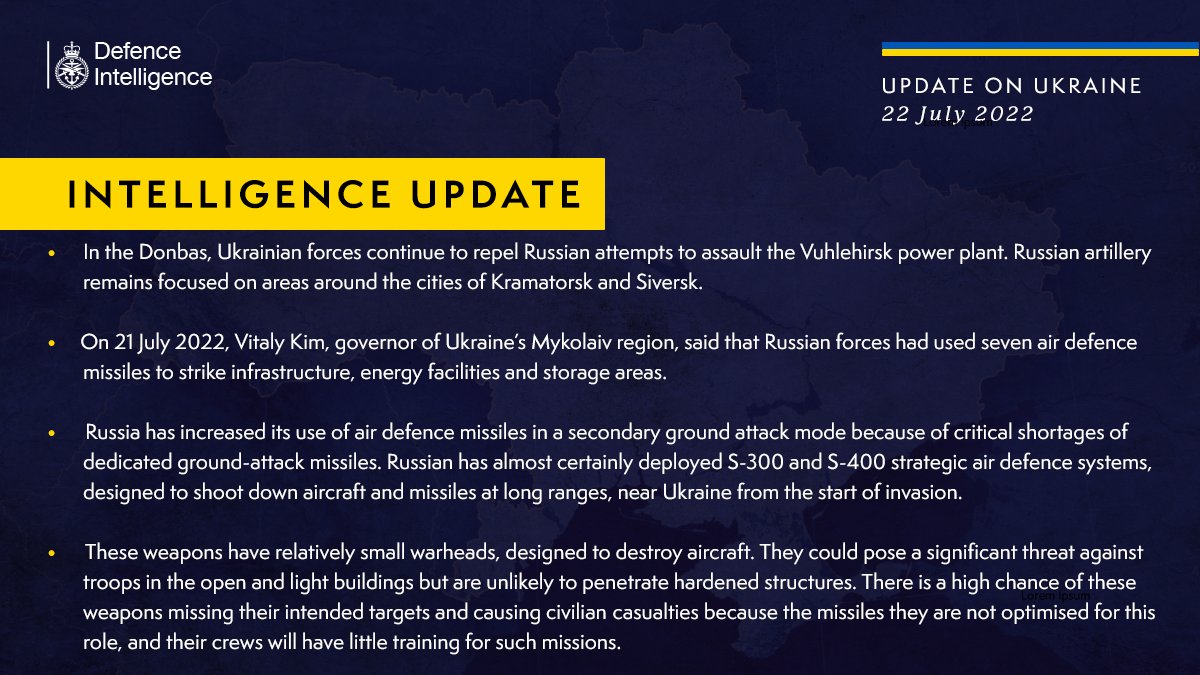
Operational Level
For the most part, the last couple of weeks has been fairly static. However, there is something substantial brewing in the southern area of operations.
Kharkiv
The northern front has been the scene of skirmishing and small-scale operations. Some villages have changed hands, sometimes a couple of times. However, the frontline remains mostly unchanged.
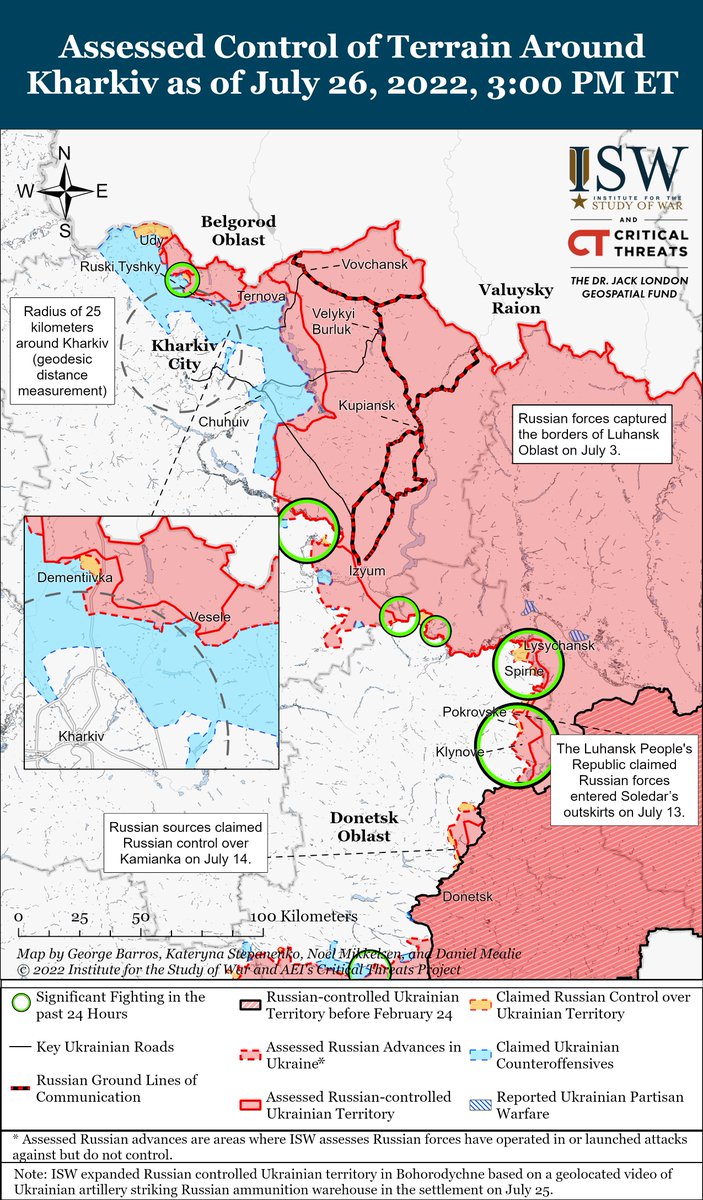
Credit: Institute for the Study of War
Donbas
The Donbas front remains, in my view, the center of gravity for the Russian operation. I think the grand scheme of creating a land bridge from Russia to Transnistria by occupying the historical boundaries of the oblasts of Luhansk, Donetsk, Zaporizhzhia, Kherson, Mykolaiv, and Odesa.

Credit: Geology.com
Both sides make limited advances and retreats.
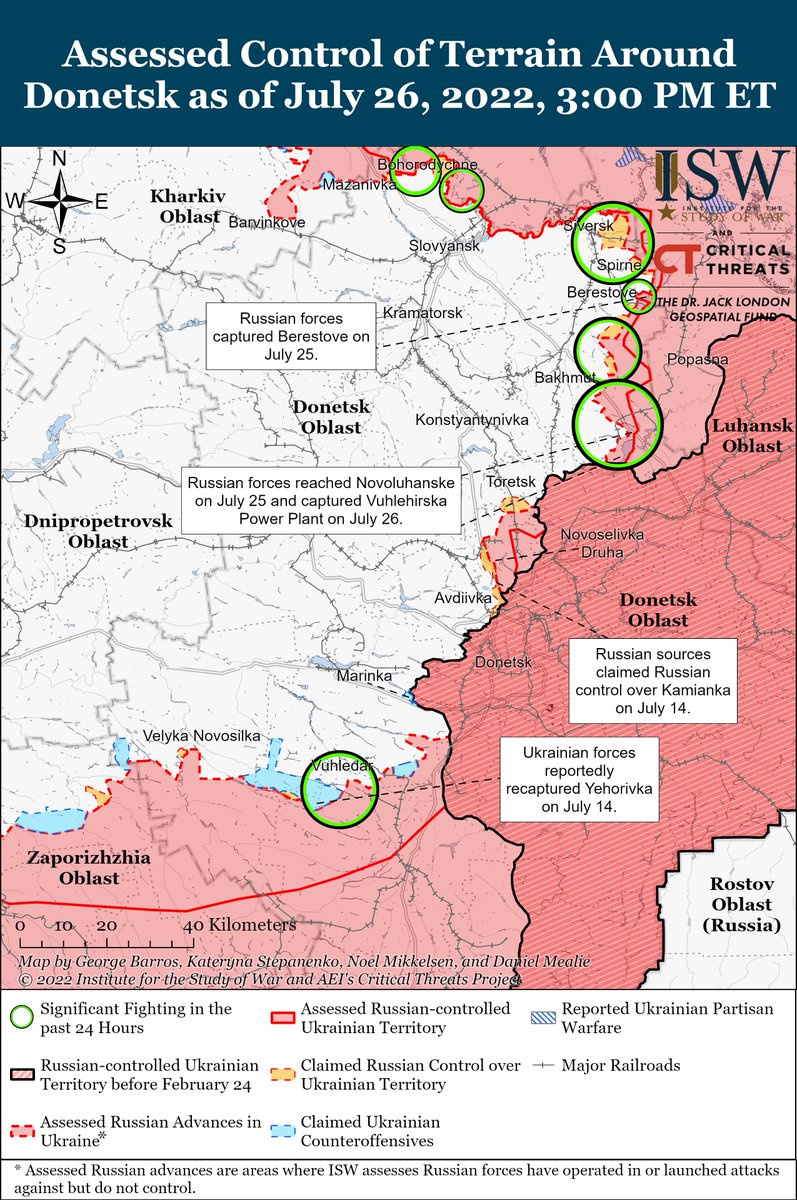
Credit: Institute for the Study of War
The major difference is that Russian artillery is not as active. Below is a comparison of fires detected by NASA satellites in Donbas. That is widely used as a proxy for artillery bombardment because eastern Ukraine doesn’t have a lot of significant fires detectable by satellite without some human intervention. The image on the left is Donbas on July 6 at the height of the Russian offensive. The image on the right is the last three days of data combined.

Credit: author
The level of artillery on the front lines is a fraction of what it was, and a lot of the artillery strikes are now landing behind Russian lines. Most of these are HIMARS strikes. This is attributable to a shortage of ammunition in Russian firing batteries due to losses of ammunition depots and increased effectiveness of Ukrainian counterbattery operations.
Kherson
The main action over the last week has been in Kherson.
The Ukrainians have made steady progress all along the front.
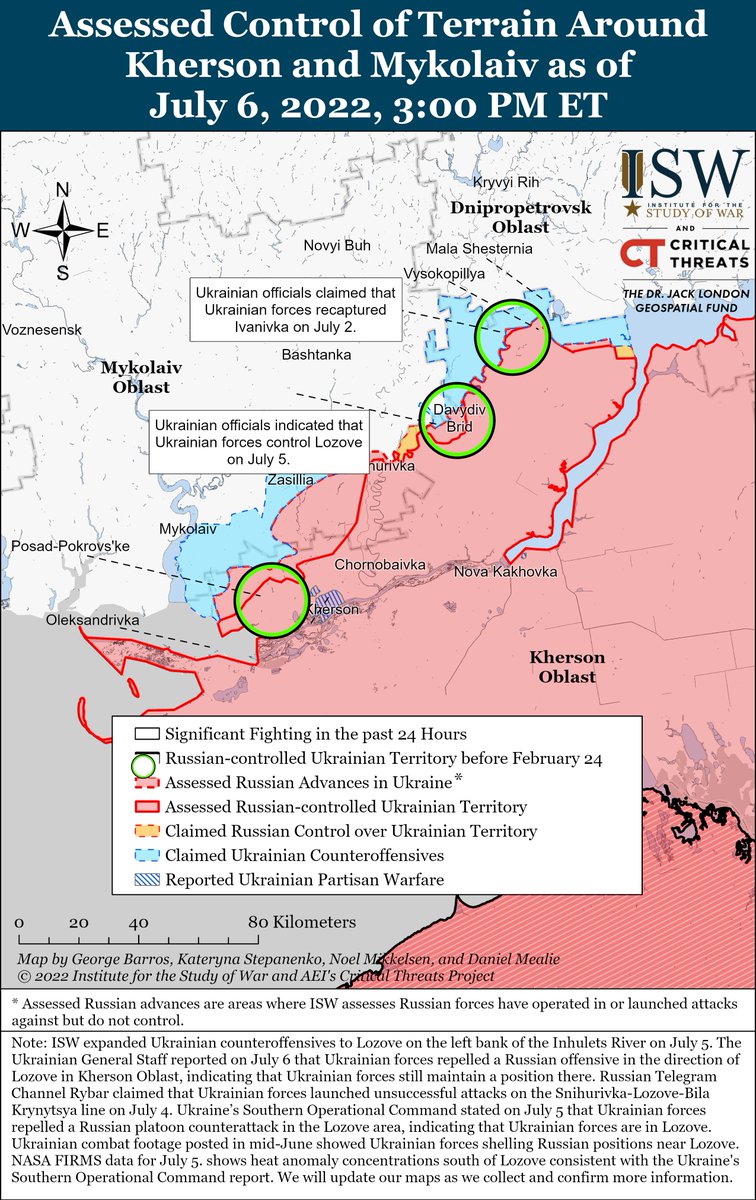
Credit: Institute for the Study of War
The Ukrainian campaign plan is much like I discussed here a few weeks ago. They are not going to throw their troops into a meatgrinder in Kherson. Instead, their strategy is to keep up the pressure all along the front, making some opportunistic gains but forcing the Russians to give up Kherson by starving them of supplies. There are three major bridges supplying Russian troops in Kherson and those troops north of the Dnipro River.
Daryivka bridge over the Ingulets River.
Череда равноудаленных точных попаданий вдоль одной полосы Дарьевского моста через реку Ингулец. pic.twitter.com/FvgPifGKYd
— IgorGirkin (@GirkinGirkin) July 23, 2022
❗️New video from the village of Daryivka, near Kherson, the bridge over the Ingulets. New damage is visible on the bridge after yesterday's shelling of the bridge. Also on the video you can see that the Russians are building a pontoon crossing over the Ingulets. pic.twitter.com/UOvFHr89cc
— Special Kherson Cat 🐈🇺🇦 (@bayraktar_1love) July 25, 2022
Bridge at the hydroelectric dam in Nova Kakhovka.
Yesterday and today, the Russian media reported that Ukraine had struck a bridge near the dam in Nova Kakhovka, but there were no confirmation.
Today there are photos of one of the craters and how the Russians are trying to patch up the road. pic.twitter.com/Pw7DNuwYd3— Georgina (@Georgin17111550) July 24, 2022
This one is key because any reinforcements or supplies from Donbas must use this bridge. I’m not sure about the quality of the repairs…
The Antonovsky Bridge.
This bridge is nearly a mile long and is the main route from Crimea to Ukraine.
One antovosky bridge in kherson said to have been struck by himars. The soft shell and low size warhead is unable to destroy such strong targets much as expected even with a unitary warhead. Mlrs historically were with sub-munitions… pic.twitter.com/aeAnwSHinQ
— dharmic aeroplate v2 (@daeroplate_v2) July 19, 2022
Antovosky Bridge, Kherson this morning: pic.twitter.com/Jf8Y9Gdq4W
— Jim Garwood (@_JimGarwood) July 20, 2022
A few hours ago, another HIMARS strike was carried out against this bridge.
CCTV video showing six impacts on the Antonivskyi bridge near Kherson
📹https://t.co/of4NkvlKWD pic.twitter.com/w5ZUPnQZaU
— Euromaidan Press (@EuromaidanPress) July 26, 2022
We’ll see the results tomorrow.
It is possible to create tactical bridges to compensate for the loss if such equipment is available. What can’t be compensated for is the volume of traffic the bridges handle. If these bridges are destroyed, the Russians can’t sustain their force in Kherson and its environs.
Summary.
Operationally, both sides have reached parity. Neither is making substantial gains of territory. In my view, the momentum at this time is swinging in favor of Ukraine. New weapons systems with trained crews are entering the battle. The weapons that are being introduced are weighted toward attritting Russian ammunition and fuel stocks. The success of this strategy is visible in Donbas. New Ukrainian formations are beginning to enter the field, and they have training that is superior to that of new Russian troops.
War has a political dimension as well as a military one. Here one has to give the edge to Putin. He’s not managing a flighty coalition fearful of winter without Russian gas. He has the power to do what it takes to prosecute the war, something I don’t think can be said for Ukraine’s allies. While Hungary’s Viktor Orban gets a lot of grief, he’s not the problem. If Germany’s Olaf Scholz were on Putin’s payroll, I’m not sure what he would do differently.
Unless something significant happens, like a collapse of one of the combatants, this war will continue to be one of attrition, and the winner will be the side that can take the most pain.


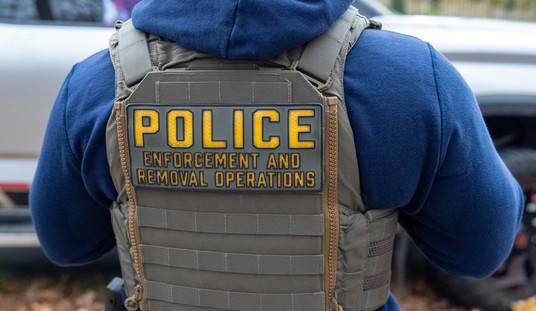

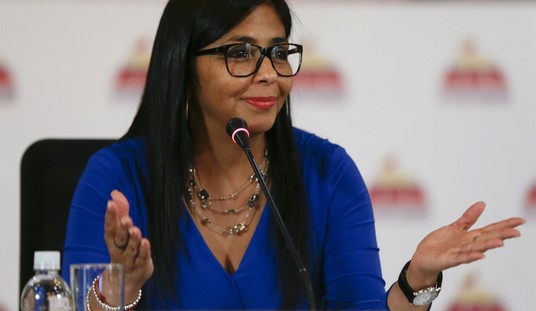
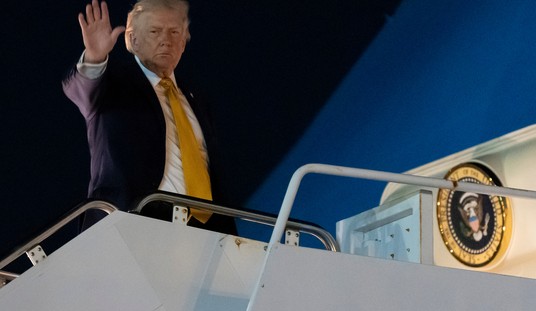





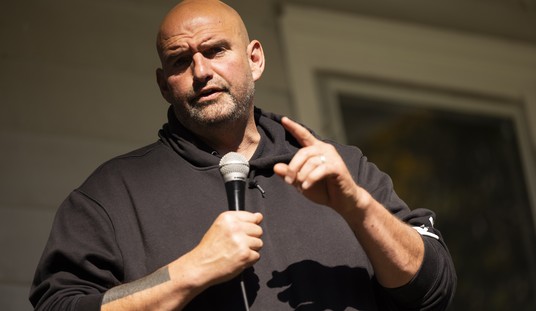
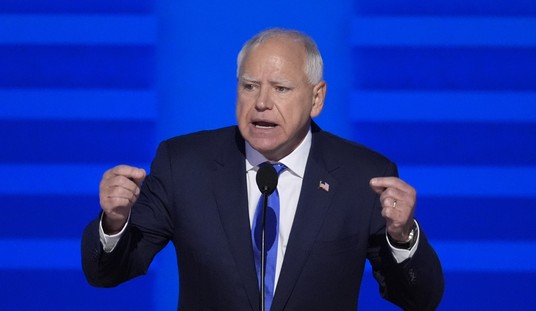

Join the conversation as a VIP Member